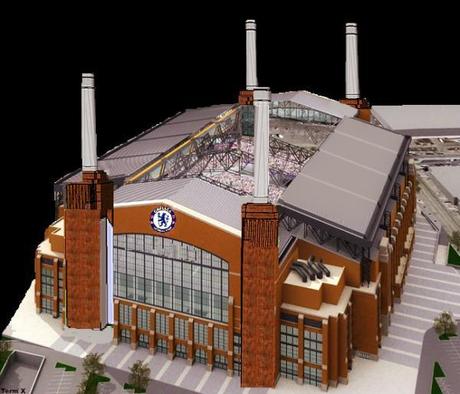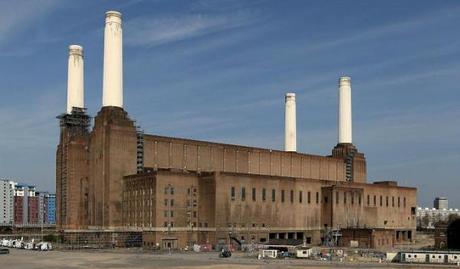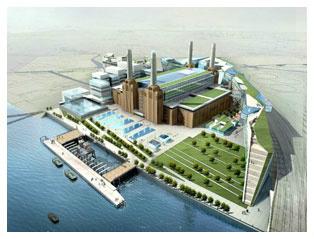
Derlen Chiu (editor del sito Footy Finance), ha twittato alcune immagini del progetto di recupero della Battersea Power Station che il Chelsea intenderebbe ristrutturare per fare il nuovo stadio.
Ecco l’area come appare:

L’operazione, che avrebbe un valore complessivo di circa un miliardo di sterline, riguarda la riqualifica dell’area della Battersea Power Station, che si estende su una superficie di 39 acri (quasi 159.000 metri quadri) ed è l’edificio in mattoni più grande d’Europa. Costruito nel 1939 è rimasto in uso fino al 1983 ed è attualmente abbandonato.
Questa la dichiarazione pubblicata sul sito del Chelsea:
Chelsea Football Club can confirm to our fans that we have today submitted an offer, with our property development partner Almacantar, to acquire the 39-acre Battersea Power Station site.
Battersea Power Station is one of London’s most famous buildings and has the potential to become one of the most iconic football stadiums in the world.
Our joint bid was submitted in accordance with the sales process established by the Joint Administrators for the site. The process could run for a number of months.
We are not the only interested parties and there is no certainty that we will be successful. We also appreciate that we have many significant hurdles to address if we are to build a new stadium on the site, including winning the support of our fans, the CPO shareholders and local Wandsworth residents, as well as securing the approval of Wandsworth Council, the Greater London Authority and heritage authorities. We must also stress that making an offer for the Battersea Power Station site does not mean the club has made a definitive decision to leave Stamford Bridge.
Working with architects and planning experts we have developed a plan to preserve all the significant aspects of Battersea Power Station. The four iconic chimneys and wash towers along with the Grade II* listed west turbine hall and control room will be restored and retained in their original locations and provide a unique architectural backdrop to a world-class stadium with a capacity of around 60,000 seats.
Following feedback from fans, our initial plans include a 15,000-all seated one-tier stand behind the south goal, likely to be the biggest one-tier stand in football. Also as suggested by many fans, the stadium proposed is rectangular in shape with four separate stands. The design includes a bigger family area and more room for disabled supporters.
As well as a new home for our club, the development would include a town centre with substantial street-level retail shops, affordable housing and offices – all of which would benefit Wandsworth and bring a significant number of permanent jobs to the area. We would also make a significant contribution towards the Northern Line Extension, a new high-volume transport link proposed for the area.
We will keep our fans updated as the process develops.
Il valore dell’area è stimato in 400 milioni di GBP, altrettanti ne serviranno per la riqualifica dell’intera area che – oltre allo stadio – prevederà aree verdi, centri commerciali, abitazioni.

Il Chelsea aveva anche un progetto di riqualifica di Stamford Birdge, ma pare che Abramovich sia attirato, oltre che dall’operazione immobiliare complessiva, anche dalla possibilità di incrementare il numero di posti in forma significativa. Lo stadio di Battersea potrebbe infatti arrivare ad una capienza di 60.000 sedute, contro le circa 42.000 attualmente disponibili. Un incremento del 42%.
A livello di ricavi, se si ipotizzasse il mantenimento di valori unitari correnti le matchday revenues potrebbero raggiungere i 105 milioni di Euro, dai 72 attuali. In realtà, l’esempio dell’Arsenal dell’Emirates Stadium ci dimostra che a fronte di un incremento dei posti del 55%, i ricavi sono più che raddoppiati, in virtù dell’estensione dell’offerta di business seats e sky box.
Rimane, come sempre, il tema del finanziamento dell’operazione. Che anche se non genera ripercussioni ai fini del Financial Fair Play (i debiti e gli interessi non sono considerati costi rilevanti perché finalizzati all’investimento sportivo), deve comunque essere tenuto in considerazione per non affossare i risultati economici della Società e condizionarne le iniziative (come insegna proprio il caso dell’Arsenal).
Negativa la reazione del Chelsea Pitch Owners (ricordiamo che lo stadio del Chelsea non è di proprietà della squadra ma di una società fatta dai tifosi), che ritengono che se l’obiettivo è solo quello di incrementare la capacità dell’impianto, anche Stamford Bridge può garantire risultati simili.




